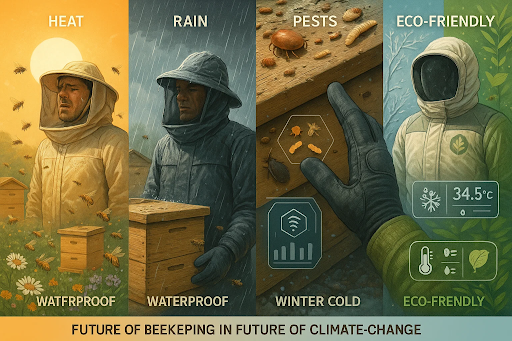Why today’s beekeeping gear needs to adapt — fast.
Beekeeping has always been about balance — between the beekeeper and the bees, between colony health and environmental changes. But as climate change accelerates, that balance is getting harder to maintain.
It’s no longer just about knowing how to manage bees — it’s about adapting everything around them, including the beekeeping gear we rely on to protect ourselves, manage hives, and ensure colony stability.
Extreme weather, longer summers, sudden frosts, invasive pests, and unpredictable seasons are forcing beekeepers to re-evaluate what gear they use and how they use it. Whether you’re a backyard hobbyist or a full-time apiarist, it’s time to ask: Is your gear built for the climate you’re working in today?
Let’s explore how the changing environment is directly impacting beekeeping gear design, material choices, and protection standards — and what you should look for in your next purchase.
🌡️ 1. Extreme Heat and the Demand for Breathable Protection
Summer inspections used to mean warm mornings and shaded checks. Now? They often mean 95°F+ afternoons, hot winds, and heat warnings. In states like Arizona, Florida, and Texas, traditional beekeeping suits — made from thick cotton or canvas — have become almost unbearable.
What’s changing in beekeeping gear:
- Mesh-layer ventilation has become standard in high-quality suits
- Suits now feature moisture-wicking linings to prevent overheating
- Light-colored, UV-reflective fabrics help reduce heat absorption
- Some brands are experimenting with cooling pad compartments
These aren’t luxury features anymore — they’re a matter of comfort and safety. Overheated beekeepers work less efficiently and are more prone to stings due to nervous movements and rushed inspections.
Bottom line: Your beekeeping gear must match your environment. Breathability is now non-negotiable.
🌧️ 2. Unpredictable Weather = Waterproof and Quick-Drying Gear
Climate change brings extreme unpredictability — sudden storms, shifting wind patterns, unexpected rain. Beekeepers who once relied on stable seasonal cycles now find themselves caught in the rain with open hives.
Modern gear adaptations include:
- Water-resistant outer layers to protect you and your tools
- Ripstop nylon reinforcements for durability and weather resistance
- Quick-drying gloves and jackets to avoid water-logging during inspections
- Hoods and veils that maintain visibility even during light rain
Even if you don’t inspect during downpours, humid and damp conditions can still ruin older suits. Mold, mildew, and rot become risks when gear doesn’t dry properly.
🐜 3. Longer Warm Seasons = More Pests (and More Frequent Inspections)
Warmer climates extend breeding seasons for pests like:
- Varroa mites
- Small hive beetles
- Wax moths
- Ants and hornets
These pests thrive in prolonged warmth and humidity, making them harder to control. Beekeepers are forced to conduct more frequent inspections, often in peak heat and under pressure.
How gear is evolving to support this:
- Easy-access zippers for fast checks
- Integrated tool pockets and clips for multitasking
- Enhanced mobility suits with flexible panels
- Sting-resistant gloves with precision fingertips
In other words, beekeeping gear now has to function more like a toolbelt — not just armor.
❄️ 4. Cold Snaps in Warm Seasons Are Still a Threat
Even with overall warming, climate change has increased the frequency of sudden cold snaps. These are especially dangerous because:
- Bees are active, expecting warmth
- Brood can be exposed to chill and die
- Hives can go into shock
For the beekeeper, unexpected cold means:
- Layered clothing becomes necessary
- Gloves must balance insulation with dexterity
- Modular suits are emerging — with detachable liners for warmth
Some suits are now designed like outdoor hiking jackets — with zip-in thermal linings and windproof hoods, giving beekeepers flexibility to adapt to changing conditions.
🌱 5. Sustainability: Eco-Friendly Gear Is on the Rise
With climate change in the spotlight, beekeepers are becoming more conscious about their own environmental impact. Gear that’s recyclable, biodegradable, or ethically produced is now in high demand.
Sustainable beekeeping gear includes:
- Organic cotton suits with non-toxic dyes
- Recycled polyester mesh panels
- Plastic-free packaging for suits and tools
- Gear made by ethical labor practices
As awareness grows, more beekeepers want gear that aligns with their values. They want to protect bees — but also the planet they live in.
🧠 6. Smart Technology Integration Is Coming
Climate change is also driving innovation. Data helps beekeepers anticipate weather, track hive health, and manage stress on colonies.
Some modern beekeeping gear now includes:
- Built-in temperature/humidity sensors in suits
- Smart veils with voice command tools
- App-connected hive gloves to log inspections in real-time
While still niche, these tech-forward solutions are part of the future of beekeeping — and they’re designed to solve problems directly caused by climate volatility.
📦 What to Look For in Your Next Beekeeping Gear Purchase
When buying new gear, climate resilience should be part of your checklist.
✅ Breathable, ventilated material (preferably triple-layer mesh)
✅ Water-resistant or quick-dry fabric
✅ Flexible, comfortable fit for longer work sessions
✅ Sting-proof yet lightweight gloves
✅ Internal pockets for tools or devices
✅ Sustainable sourcing, if possible
✅ Thermal adaptability for sudden cold snaps
✅ Modular accessories for all seasons
And of course, ensure your gear has proper seals — cuffs, ankles, and veils should zip or tighten securely to keep your bees where they belong.
🐝 Final Thoughts: The Climate is Changing — Your Gear Should Too
Beekeeping has never been static. As flowers bloom earlier, winters become unpredictable, and pests stay active year-round, the way we interact with our hives must evolve.
Beekeeping gear is no longer just about basic sting protection — it’s now about heat management, weather adaptation, mobility, and environmental responsibility.
Whether you’re inspecting a rooftop hive in Miami or managing dozens of colonies in rural Montana, your gear is part of your success. And in a warming world, that gear needs to be smarter, lighter, and stronger than ever before.
The bees are adapting — it’s time we do too.
